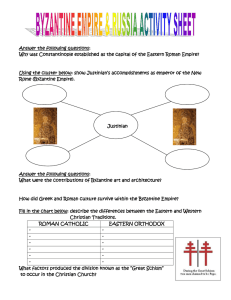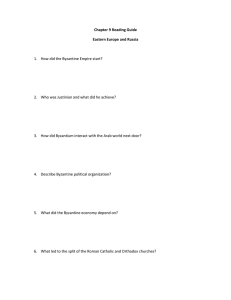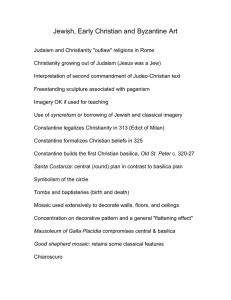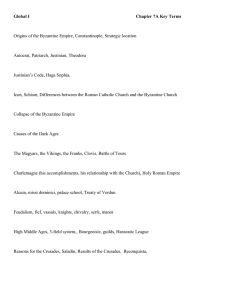Secular Life Old Forms -New Symbols The Temples of the New
advertisement
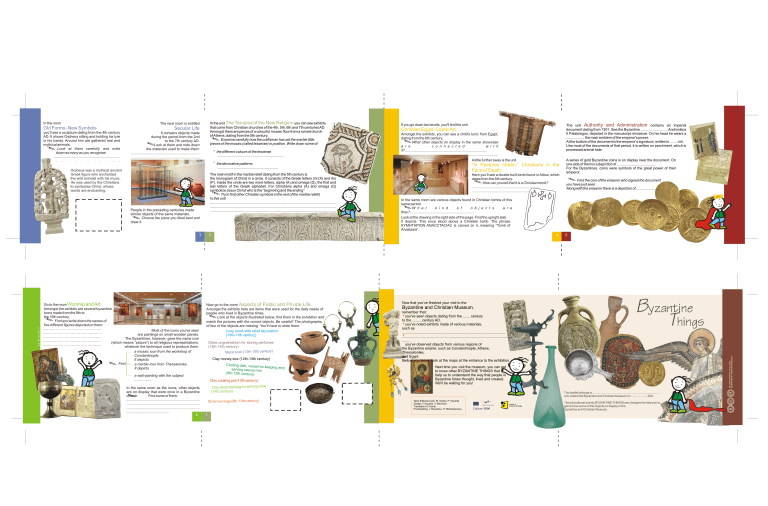
Old Forms -New Symbols you'll see a sculpture dating from the 4th century AD. It shows Orpheus sitting and holding his lyre in his hands. Around him are gathered real and mythical animals. Look at them carefully and write down as many as you recognise: ................................................................. . . . . . . . . . . . . . Secular Life It contains objects made during the period from the 2nd to the 7th century AD. Look at them and note down the materials used to make them: .................................................................... .................................................................... the different colours of the tesserae .................................................................. Amongst the exhibits, you can see a child's tunic from Egypt, dating from the 6th century. What other objects on display in the same showcase a r e c o n n e c t e d w i t h it?.................................................................................. ................................................................................................ A little further away is the unit Orpheus was a mythical ancient Greek figure who enchanted the wild animals with his music. He was used by the Christians to symbolise Christ, whose words are enchanting. The main motif in the marble relief dating from the 5th century is the monogram of Christ in a circle. It consists of the Greek letters chi (X) and rho (P). Inside the circle are two more letters, alpha (A) and omega (Ω), the first and last letters of the Greek alphabet. For Christians alpha (A) and omega (Ω) symbolize Jesus Christ who is the “beginning and the ending” Try to find other Christian symbols in the rest of the marble reliefs In this unit. ............................................................................................................................. ............................................................................................................................. ............................................................................................................................. People in the preceding centuries made similar objects of the same materials. Choose the piece you liked best and draw it. 2 1. 2. 3. 4. 5. Christian Egypt. Coptic Art. the decorative patterns ............................................................ Go to the room Worship and Art. Amongst the exhibits are several byzantine icons made from the 9th to the 15th century. Find and write down the names of five different figures depicted on them: …………………………………………. Most of the icons you've seen …………………………………………. are paintings on small wooden panels. ……………………………………….... The Byzantines, however, gave the name icon ……………………………………….... (which means “picture”) to all religious representations, ……………………………………….... whatever the technique used to produce them. a mosaic icon from the workshop of Constantinople. It depicts Find a marble icon from Thessalonike. It depicts “In Pastures Green.” Christians in the Face of Death. Here you'll see a double built tomb found in Attica, which dates from the 6th century. How can you tell that it is a Christian tomb? .................................................................... .............................................................. 4 Now go to the room Aspects of Public and Private Life. Amongst the exhibits here are items that were used for the daily needs of people who lived in Byzantine times. Look at the objects illustrated below, find them in the exhibition and match the pictures with the correct objects. Be careful! The photographs of two of the objects are missing. You'll have to draw them. Ivory comb with relief decoration (10th-11th century) Glass unguentarium for storing perfumes (13th-14th century) Metal bowl (13th-15th century) Clay money-box (12th-13th century) Chafing dish, vessel for keeping and serving sauces hot (9th-12th century) Clay cooking pot (13th century) Clay decorated jag for serving wine (14th century) Silver earrings (9th-10th century) 7 A series of gold Byzantine coins is on display near the document. On one side of them is a depiction of ...................................... For the Byzantines, coins were symbols of the great power of their emperor. Find the coin of the emperor who signed the document you have just seen. Along with the emperor there is a depiction of ....................... In the same room are various objects found in Christian tombs of this same period. W h a t k i n d o f o b j e c t s a r e they?................................................................ Look at the drawing in the right side of the page. Find the upright slab It depicts. This once stood above a Christian tomb. The phrase ΚΥΜΗΤΗΡΙΟΝ ΑΝΑCCTACIAC is carved on it, meaning “Tomb of Anastasia”. 3 a wall-painting with the subject ................. In the same room as the icons, other objects are on display that were once in a Byzantine church. Find some of them: ........................................................................ ........................................................................ ........................................................................ .......................................... 6 The unit Authority and Administration contains an imperial document dating from 1301. See the Byzantine ........................... Andronikos II Palaiologos, depicted in the manuscript miniature. On his head he wears a ................., the main emblem of the emperor's power. At the bottom of the document is the emperor's signature, written in ........ ink. Like most of the documents of that period, it is written on parchment, which is processed animal hide. If you go down two levels, you'll find the unit 5 Now that you've finished your visit to the Byzantine and Christian Museum, remember that: you've seen objects dating from the ....... century to the ......... century AD. you've noted exhibits made of various materials, such as ....................................................................................................... .............................................................................................................. ........ you've observed objects from various regions of the Byzantine empire, such as Constantinople, Athens, Thessalonike, and Egypt. Before you leave, look at the maps at the entrance to the exhibition. HELLENIC MINISTRY OF CULTURE In the unit The Temples of the New Religion you can see exhibits that come from Christian churches of the 4th, 5th, 6th and 7th centuries AD. Amongst them are pieces of a colourful mosaic floor from a ruined church of Athens, dating from the 5th century. Examine carefully how the craftsman has set the marble little pieces of the mosaic (called tesserae) in position. Write down some of: The next room is entitled Next time you visit the museum, you can get to know other BYZANTINE THINGS that help us to understand the way that people in Byzantine times thought, lived and created. We'll be waiting for you! This leaflet belongs to ................................................................................. who visited the Byzantine and Christian Museum on .................., 200.. Texts Editorial Care: St. Gotsis, P. Vosnidis Design: Y. Soupios, Y. Stavrinos Translation: D. Hardy Proofreading: J. Moysidou, H. Michalopoulou The educational activity BYZANTINE THINGS was designed to help you to get to know some of the objects on display in the Byzantine and Christian Museum. BYZANTINE & CHRISTIAN MUSEUM In the room
